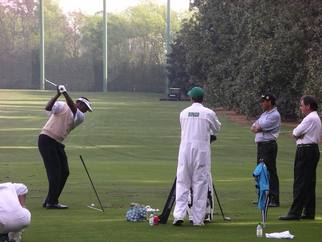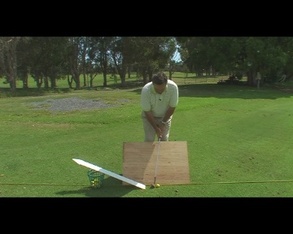 The most effective practice drills golf tour player’s and leading amateur golfers use are the drills that are designed specifically to help them to make the transition from the practice tee to the golf course as easily and quickly as possible. In this golf instruction article I’ll explain how performing a golf practice drill correctly will significantly improve your chances of taking it to the golf course without the usual prolonged distress usually associated with golf swing changes using what I call the “5 D Success Formula.” The less complicated a change to your golf swing is, the faster you can adapt to the changes on the golf course. The biggest challenge facing any golfer is the fear that the change to your golf technique will leave you in a kind of “golf swing limbo” where you can’t go back to your old golf swing, and you haven’t got enough trust in your new golf swing. So the more elements of a golf swing you have to focus on to improve your technique the more destructive it is to your golf confidence. Quite simply, if you’re thinking about more than one swing thought as you swing the golf club you will more-than-likely fail to execute your golf shots with a high degree of precision and consistency. A helpful way to understand this is to recognize two important factors in changing your golf swing with golf practice drills. One is the actual drill itself and the second is its level of complexity. When you focus on performing one simple training drill like cocking your wrists before you swing your arms back is a relatively easy exercise to accomplish.  However when you attempt to combine two practice routines at the same time, the complexity level jumps up significantly. Basically the complexity of the drill sky rockets for every additional component you add to your training drill. The simplest example I can share with you is the golfer who performs a particular technical drill on the driving range and at the same time attempts to hit his golf shot accurately to a target. "Basically the complexity of the drill sky rockets for every additional component you add to your training drill. The simplest example I can share with you is the golfer who performs a particular technical drill on the driving range and at the same time attempts to hit his golf shot accurately to a target." It might seem harmful-even easy to do and yet it is arguably the single biggest reason why amateur golfers struggle to make the transition from driving range to golf course. The whole idea behind performing golf practice drills is to facilitate a change in your golf technique faster and more effectively than just hitting golf shots and attempting to change your technique through repetition alone. Golf practice drills help you to change a portion of your technique and integrate the change smoothly into your overall technique. The key is to reduce complexity, increase competency which ultimately leads to increased golf confidence on the golf course. So how do tour pro’s practice their drills? "Very carefully, and by concentrating on one piece of the puzzle at a time..." Tour pro’s have discovered through countless hours of practice on the driving range that attempting to focus on performing a drill and trying to hit a perfect shot at the same time is the equivalent of speaking on your mobile phone whilst driving in traffic. It’s difficult to do, dangerous, and the outcome is not likely to be helpful in the long run. The best type of practice drill is the one that helps you to hit your golf shot straighter and more solidly time and time again. This seems logical enough and yet it’s surprising how many golfers practice drills that are not compatible with their particular problem. For instance a golfer might be practicing a split hands drill where you hold each end of the grip with a gap in the middle to help facilitate the rotation of the club-face through the impact zone to straighten a persistent slice shot. The problem in this example is that often this drill is used to try and fix an over-the-top downswing, whereas this type of drill is actually designed for the bottom of the swing, as opposed to the top of the swing which is where an over-the-top down swing problem originates. You can waste a lot of hours toiling away at golf practice drills that are incompatible with your particular swing needs.  Here is the “Five D Success Formula” which is a practice drill framework you can follow that will make certain that you’re on the right track as you go through the golf swing change process.
By following this practice drill framework you will keep your focus on habituating the most relevant part of your golf swing technique. You will need to repeat the practice drill you've chosen at least one thousand five hundred times before you start to reach the stage of development called “unconscious competence.” This is high trust stage of golf swing performance where you can hit golf shots without thinking about how you hit golf shots. Don’t be put off by the amount of repetition required; you cannot achieve this superior level of performance without at least this amount of repetition so just give yourself the time to do the drill work. Twenty five correctly performed drills per day for sixty days in front of a mirror at home and you’ll have incorporated a new part into your golf swing technique. If you want to achieve it faster than that you can perform fifty repetitions three times per day for ten days and you’ll create the same effect. Either way, you should memorize this simple mantra; “repeat regularly to re-train and retain.” The positive side of performing your golf practice drills regularly is that they will lead you directly towards a great deal more golf confidence and ultimately much improved performances on the golf course which will translate into lower golf scores and far more enjoyment. Lawrie Montague Comments are closed.
|
Archives
June 2019
|
Proudly Supported By
Copyright © 2011 - 2018 Pro Tour Golf College
Website Managed By Golf Performance Media
All Rights Reserved
Website Managed By Golf Performance Media
All Rights Reserved

 RSS Feed
RSS Feed



